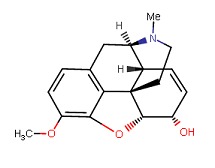NCBI Bookshelf. A service of the National Library of Medicine, National Institutes of Health.
LiverTox: Clinical and Research Information on Drug-Induced Liver Injury [Internet]. Bethesda (MD): National Institute of Diabetes and Digestive and Kidney Diseases; 2012-.

LiverTox: Clinical and Research Information on Drug-Induced Liver Injury [Internet].
Show detailsOVERVIEW
Introduction
Codeine is one of the natural plant alkaloids found in extracts of opium and is commonly used to treat mild-to-moderate pain and cough. Codeine, like other opioids, has not been linked to serum enzyme elevations during therapy or to clinically apparent liver injury.
Background
Codeine (koe’ deen) is a natural alkaloid derived from resin extracts from the seeds of the opium poppy, Papaver somniferum. Codeine has opiate-like analgesic effects, but is much less potent than morphine. Codeine, however, is well absorbed orally and is less likely to cause serious respiratory depression than morphine. Codeine has been used in clinical medicine for more than a century and is currently approved for use in the United States as an oral analgesic for mild-to-moderate pain and, in low doses, as an antitussive for suppression of nonproductive cough. Codeine is available in multiple formulations including oral tablets of 15, 30 and 60 mg, as well as oral solutions and solutions for injection (subcutaneously, intramuscularly, intravenously) in varying concentrations. The typical adult, oral dose of codeine for analgesia is 15 to 60 mg every 4 to 6 hours. In addition, multiple commercial products combining codeine with acetaminophen for therapy of mild-to-moderate pain are available generically and under brand names such as Codrix and Codet. Side effects of codeine include sedation, respiratory depression, mental clouding, euphoria, agitation, constipation, abdominal bloating, nausea, vomiting and constipation. Codeine is a controlled substance and classified as a Schedule III drug, indicating that it has medical usefulness, but also a potential for physical and psychological dependency and abuse. Codeine is also available in low concentrations (~12 mg/tablet) in combination with antihistamines, antitussants or sympathomimetic agents for symptomatic therapy of upper respiratory infections and cough. These products are typically available over-the-counter without prescription.
Hepatotoxicity
Despite wide use for many years, codeine has not been linked to serum enzyme elevations during therapy and there have been no convincing cases of idiosyncratic acute, clinically apparent liver injury attributed to its use.
Liklihood score: E (unlikely cause of clinically apparent liver injury).
References on the safety and potential hepatotoxicity of codeine are given in the Overview section of the Opioids.
Drug Class: Opioids
PRODUCT INFORMATION
REPRESENTATIVE TRADE NAMES
Codeine – Generic, Codrix®
DRUG CLASS
Opioids
Product labeling at DailyMed, National Library of Medicine, NIH
CHEMICAL FORMULA AND STRUCTURE
| DRUG | CAS REGISTRY NO. | MOLECULAR FORMULA | STRUCTURE |
|---|---|---|---|
| Codeine | 76-57-3 | C18-H21-N-O3 |
 |
- Review Opioids.[LiverTox: Clinical and Researc...]Review Opioids.. LiverTox: Clinical and Research Information on Drug-Induced Liver Injury. 2012
- Review Opium alkaloids, biosynthesis, pharmacology and association with cancer occurrence.[Open Biol. 2023]Review Opium alkaloids, biosynthesis, pharmacology and association with cancer occurrence.Vadhel A, Bashir S, Mir AH, Girdhar M, Kumar D, Kumar A, Mohan A, Malik T, Mohan A. Open Biol. 2023 May; 13(5):220355. Epub 2023 May 3.
- Concentrations of the Opium Alkaloids Morphine, Codeine, and Thebaine in Poppy Seeds are Reduced after Thermal and Washing Treatments but are Not Affected when Incorporated in a Model Baked Product.[J Agric Food Chem. 2020]Concentrations of the Opium Alkaloids Morphine, Codeine, and Thebaine in Poppy Seeds are Reduced after Thermal and Washing Treatments but are Not Affected when Incorporated in a Model Baked Product.Shetge SA, Dzakovich MP, Cooperstone JL, Kleinmeier D, Redan BW. J Agric Food Chem. 2020 May 6; 68(18):5241-5248. Epub 2020 Apr 27.
- Review Medications Containing Low-Dose Codeine for the Treatment of Pain and Coughs[ 2021]Review Medications Containing Low-Dose Codeine for the Treatment of Pain and CoughsYoung C, Loshak H. 2021 Aug
- Update of the Scientific Opinion on opium alkaloids in poppy seeds.[EFSA J. 2018]Update of the Scientific Opinion on opium alkaloids in poppy seeds.EFSA Panel on Contaminants in the Food Chain (CONTAM), Knutsen HK, Alexander J, Barregård L, Bignami M, Brüschweiler B, Ceccatelli S, Cottrill B, Dinovi M, Edler L, et al. EFSA J. 2018 May; 16(5):e05243. Epub 2018 May 16.
- Codeine - LiverToxCodeine - LiverTox
Your browsing activity is empty.
Activity recording is turned off.
See more...